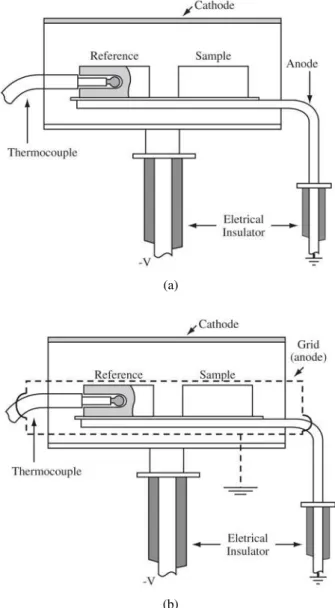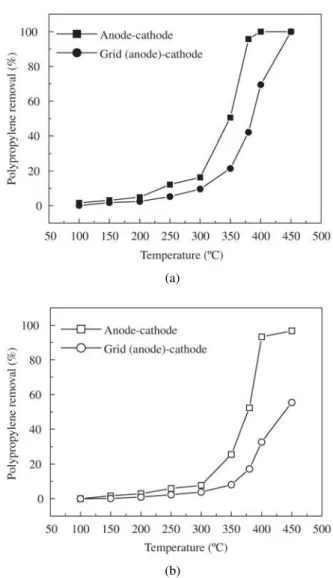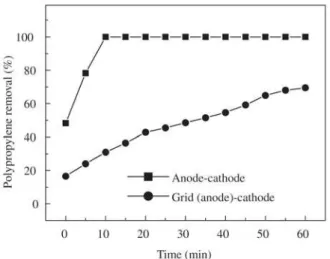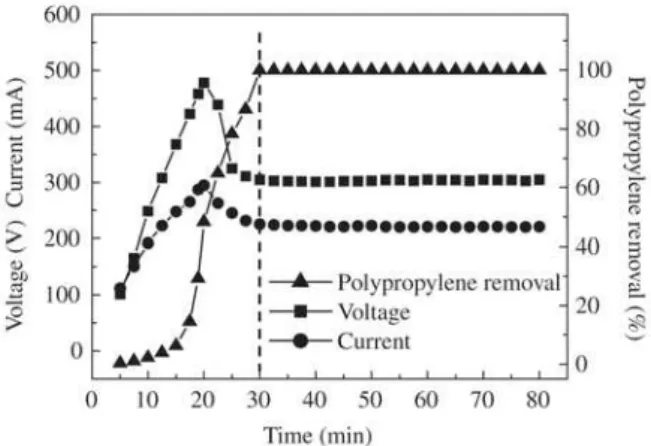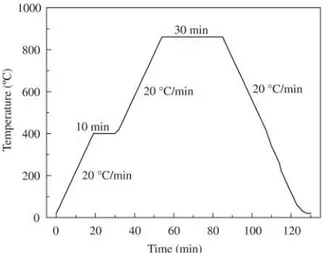*e-mail: muzart@materiais.ufsc.br
Article presented at the XV CBECIMAT, Natal - RN, November/2002
Plasma Debinding and Pre-Sintering of Injected Parts
Maria Antônia dos Santos, Matheus Piazzalunga Neivock, Ana Maria Maliska,
Aloísio Nelmo Klein, Joel Louis Rene Muzart*
Universidade Federal de Santa Catarina - Departamento de Engenharia Mecânica-LabMat Campus Universitário, 88040-900 Florianópolis - SC, Brazil
Received: March 14, 2003; Revised: April 5, 2004
Results of polypropylene removal in injected metallic parts by using plasma technology are presented. The samples were injected with 55.18% Vol. of unalloyed iron powder, 23.57% Vol. of paraffin and 21.25% Vol. of polypropylene. The paraffin was previously removed in hexane bath, followed by a treatment in abnormal glow discharge of argon and hydrogen for the removal of the polypropylene. The electric discharge was generated in two configurations: a confined anode-cathode with the samples placed on the anode and a confined grid (anode)-anode-cathode system with the sample placed on a holder at floating potential inside the grid. In the first geometry, electrons bombarded the sample surface, while in the second, they are collected by the grid. The samples were characterized by mass loss measurements and scanning electron microscopy. The results showed that the hydrogen discharge was more efficient for both configurations, which is attrib-uted to the high reactivity of hydrogen atoms produced in the discharge. In addition, when plasma debinding was performed at 400 °C for 10 min, by using the confined anode-cathode configura-tion, the polypropylene removal was total, while in the confined grid (anode)-cathode geometry the removal was approximately 32%. The higher polypropylene removing observed in the anode-cathode configuration is attributed to electron bombardment of the surface of the sample.
Keywords: powder injection moulding, plasma, debinding, sintering
1. Introduction
The production of parts by using the Powder Injection Moulding (PIM) technique constitutes an alternative proc-ess for the confection of parts of complex forms in great quantity1. In order to obtain a feedstock of suitable
viscos-ity to perform the injection, thermoplastic materials are mixed with the metal powder2-4. The binders typically used
are: paraffin, polypropylene, polystyrene, polyethylene and polyacetal. Before sintering, the organic binder must be re-moved without disrupting the particles, which is a delicate process1. The techniques most commonly used are:
chemi-cal-thermal, supercritical, catalytic and in vacuum. The chemical-thermal technique, consists in immersion in vapor or liquid hexane at low temperature, typically 50 °C, in or-der to dissolve at least one binor-der phase, producing an open porosity, followed by binder burnout. The mechanism of thermal degradation of the organic binder is based on the successive dissociation of the polymer, producing light molecules, which are evaporated out of the surface of the component. However, the thermal process is an inefficient
dissociation mechanism resulting in a poor etching of the piece surface. Consequently, temperature may produce an excessive increase of vapor pressure in the core of the part, resulting in the occurrence of defects. In order to avoid the occurrence of defects as cracks or shape deformation, low heating rate (< 0.5 °C/min) are generally used, resulting in a long processing time, typically ranging from 10 to 50 h5,6.
discussed by German and Bose1, in low-pressure system, a
vacuum pump is used to continuously pull binder vapor away from the heated parts. At first, the heating rate is typically 0.5 °C/min. or less until 100 °C, this temperature being matained for times up to 4 h. Subsequently, temperature is in-creased to 400 °C using a heating rate around 1 °C/min and then maintaining it for another 2 h. The pieces are constantly exposed to a gas flow, in order to remove the binder vapors, which are condensed and collected in a trap. Finally, when most of the binder is removed, the temperature may be pro-gressively increased and sintering could be performed in a unique thermal cycle. This is the major advantage of the vacuum technique. However, considering that the binder degradation is performed by thermal mechanism, the proc-ess is relatively slow, lasting more than 10 h. In addition, hydrocarbon molecules deposit on the support of the pieces and on the walls of the vacuum furnace requiring periodic cleaning of the equipment. The application of glow discharge on powder metallurgy processing is mainly used for clean-ing7, delubing8 and sintering9-15. Recently, a novel
applica-tion to perform the debinding of components produced by injection molding was briefly published16,17, and is
dis-cussed in more details in this paper. The plasma technol-ogy applied to the extraction of binders is an alternative that consists in the use of high kinetic energy of the elec-trons to dissociate the hydrocarbon molecules, resulting in an activated debinding. The pieces are constantly exposed to a gas flow and light radicals or molecules produced by the dissociation of the binder are pumped out of the fur-nace. In addition, the reactive species generated in the glow discharge resulted in an efficient cleaning of the supports and walls of the plasma reactor. As in the vacuum tech-nique, debinding and sintering could be performed in a unique thermal cycle, using the same equipment. As a con-sequence of the activated debinding cycle, the total process-ing time is significantly reduced.
2. Experimental
The plasma reactor was constituted of Pyrex cylindrical chamber closed in both ends by stainless steel lids. The sys-tem was pumped down by a two-stage mechanical pump until a residual pressure of less than 1.3 Pa (0.01 Torr) was reached. For debinding step, hydrogen (99.998% pure) or argon (99.999% pure) was introduced in the vacuum cham-ber by using two Datametrics mass flow controllers. The pre-sintering gas mixture of argon/hydrogen was adjusted by using the two mass flow controllers. The pressure in the vacuum chamber was adjusted by manual valves and meas-ured using an Edward capacitance manometer of 1330 Pa (10 Torr) full-scale. The electric discharge was generated by using a square waveform pulsed power source with the negative voltage output connected to the cathode and the
positive was grounded. The power transferred to the plasma was adjusted by varying the time switched on (ton) of the pulse, which could be varied from 10 to 180 µs and the total on/off time was 200 µs. The voltage was fixed in 610 and 480 V for hydrogen and argon respectively. The con-fined anode-cathode configurations are presented in Fig. 1. Both electrodes were manufactured of AISI 1020 steel and electrically insulated. The outer electrodes, of a rectangular form, 50 mm long, 40 mm in height and 30 mm in width were connected to the negative voltage and heated by ion bombardment. The inner electrode consisted of a plate 10 mm in width and a thickness of 2 mm. The samples, placed on the inner electrode, were heated by radiation from the cathode and the temperature was measured using a
ther-(b) (a)
mocouple (Chromel Alumel type-K) inserted 5 mm into the reference sample.
Polypropylene extraction was performed in the two con-figurations presented in Fig. 1. By using the first geometry (Fig. 1a), the sample holder was grounded, working as the anode of the discharge and consequently was bombarded by low-energy ions and energetic electrons, as discussed by Chapman18. As a consequence of the confined geometry,
the sample was also surrounded by reactive species gener-ated in the plasma. The second geometry presented in Fig. 1b, consisted in a confined grid (anode)-cathode con-figuration, with the sample placed in a holder electrically insulated, i.e. at floating potential, and the grid was grounded. In this case, the grid was the anode and collected the low energy ions and the electrons. Therefore, by using such a configuration, the sample is only submitted to the reactive species produced in the plasma.
The samples were injected in the proportion of 55.18% Vol. of iron powder, 23.57% Vol. of paraffin and 21.25% Vol. of polypropylene. The paraffin was chemically removed using hexane as solvent heated at 50 °C for 6 h, in order produce an open porosity. The plasma degradation of polypropylene was carried out in the confined anode-cath-ode and confined grid (ananode-cath-ode)-cathanode-cath-ode configurations with the sample placed on the anode or at floating potential re-spectively. The discharge was generated in argon or hydro-gen gas, flowing at 3.3.10-6 m3.s-1 (200 sccm) maintaining
the pressure at 400 Pa (3 Torr). The polypropylene removal was studied as a function of time and temperature.The heat-ing rate was approximately of 20 °C/min. After the binder’s removal, pre-sintering was performed at 860 °C, in the elec-tric discharge of a 20% H2 + 80% Ar gas mixture flowing at 3.3.10-6 m3.s-1 (200 sccm), at a pressure of 1200 Pa (9 Torr)
during 30 min. The heating and cooling rates were approxi-mately 20 °C/min.
Polypropylene removal was quantified by mass loss measurements using a 5.10-5 g precision balance. As the
to-tal weight of the sample, around 2.583 g, was constituted of 0.104 g of polypropylene and 2.479 g of iron, the mass loss measurements were obtained with very good accuracy. The mass loss percent was calculated considering only the mass of polypropylene. Microstructural characterization of the sample was performed by using a scanning electron micro-scope (Philips XL-30).
3. Results and Discussion
The results are presented in two parts: the study of polypropylene removal and the achievement of an optimized binder extraction cycle, followed by the pre-sintering step.
3.1. Influence of temperature on the polypropylene removal
Results of polypropylene extraction as function of tem-perature using the confined anode-cathode and grid
(anode)-cathode configurations in glow discharge of hydrogen and argon are presented in Fig. 2a and 2b respectively. After reaching the fixed temperature, the debinding step lasted 60 min.
In all experiments, for temperatures lower than 300 °C, a small fraction (< 20%) of polypropylene was removed, which is attributed to the low diffusion rate of the binder from the core to the surface. In hydrogen discharge, the polypropylene removal was total at 400 °C by using the anode-cathode configuration while in the grid configura-tion the extracconfigura-tion was around 69% (Fig. 2a). Similar re-sults were obtained in argon discharge (Fig. 2b), however of lower values, approximately 93 and 39% respectively. As discussed previously, when the sample was placed onto the anode, the surface was submitted to electron impact. As
Figure 2. Variation of polypropylene removal as a function of tem-perature, performed in: a) hydrogen; b) argon discharge. The processing time was of 60 min.
(a)
a consequence, the energetic electrons, by inelastic colli-sions, resulted in the dissociation of polypropylene, pro-ducing light radicals or molecules as CH× (× = 1, 2, 3 or 4), which were pumped out of the vacuum chamber. By using the grounded grid configuration, the electrons are collected by the grid and the sample surface was not submitted to the electron bombardment. Therefore, it can be concluded that the electron impact on the surface of the sample resulted in an activated debinding. A comparative analysis of the polypropylene removal, performed in different gas dis-charge, showed that the hydrogen gas resulted in a higher binder removing, in both configurations. Such an effect is attributed to the production of hydrogen atoms, in the glow region, which, due to the confined configuration, efficiently reacted with the organic binder at the surface of the sample. In addition, the deposition of hydrocarbon observed on the supports of the parts and on the walls of conventional fur-nace during the debinding step does not occur by using the plasma process. So, periodic cleaning of the furnace is no longer more required due to the efficient etching produced by the reactive species generated in the glow discharge. To summarize, it is demonstrated that both, the effect of elec-tron impact and the chemical reaction of hydrogen atoms, on the sample surface resulted in an activated binder re-moval.
3.2. Polypropylene removal as a function of time in hydrogen discharge
Figure 3 shows the variation of polypropylene extrac-tion as a funcextrac-tion of the processing time. The glow discharge was generated in hydrogen gas, at 400 °C and processing time ranged from 0 to 60 min, in the confined anode-cath-ode and confined grid (ananode-cath-ode)-cathanode-cath-ode configurations. The
heating rate was approximately of 20 °C/min until the tem-perature of 400 °C was reached and then was maintained constant as a function of time.
The polypropylene removal measured at time t = 0 was of approximately 48% in the confined anode-cathode con-figuration and 16% by using the grid. This value corre-sponded to the time required to reach the temperature of 400 °C, i.e., about 20 min. In the confined anode-cathode configuration the polypropylene removal was total in a treat-ment time of 10 min at 400 °C, while in the confined grid (anode)-cathode configuration the same value was not reached even for 60 min. These results confirm what was observed in the study of polypropylene removal as a func-tion of temperature, especially the importance of the im-pact of electrons on the sample surface resulting in the dis-sociation of the organic molecules of the binder. By using a hydrogen discharge, generated in the confined anode-cath-ode configuration with the sample placed on the ananode-cath-ode, the polypropylene removal was achieved in a total processing time of 30 min. The previously mentioned time of 30 min necessary to perform a complete debinding was obtained in a laboratory plasma reactor with only one sample. Certainly, in an industrial plasma reactor, the processing time for debinding step will be significantly higher. This is mainly due to the following factors: firstly, a suitable temperature homogeneity in the all the vacuum chamber had to be main-tained in order to perform an uniform binder extraction in the all load; secondly, the degradation rate of polypropylen had to be sufficiently low, as to maintain a suitable purity of the gas discharge, in order to perform the debinding step without deposition of soot or hydrocarbon on the pieces, supports or walls of the reactor. However, the electron bom-bardment on the sample surface strongly increases the binder degradation, as previously discussed. Thus, it could be con-cluded from the present experimental results that industrial plasma reactor may have better performance than indus-trial vacuum or thermal furnace.
Micrographs of samples without binder, with polypropylene and after the plasma treatment at 400 °C in hydrogen discharge during 10 min are presented in Figs. 4a, 4b and 4c respectively. It can be observed that the micro-graphs of Fig. 4a and 4c are similar, both different of the image presented in Fig. 4b, illustrating that the polypropylene was removed from the injected sample after plasma treatment.
3.3. Variation of plasma parameter during the polypropylene removal
Results of the variation of the macroscopic parameters (average voltage and current) of the electric discharge dur-ing the polypropylene removal are presented in Fig. 5. The measurements were performed in the confined anode-cath-ode configuration of hydrogen discharge, since the begin-Figure 3. Variation of polypropylene removal as a function of time,
ning of the process at 20 °C until the temperature of 400 °C was reached and kept for 60 min. During the first 20 min the power transferred to the plasma was increased in order to reach the temperature of 400 °C, with a corresponding increase of the average voltage and current. At that time, approximately 50% of polypropylene was removed. Fol-lowing, in order to maintain the temperature at 400 °C, the power transferred to the discharge had to be lowered and consequently the average voltage and current decreased. After thirty min, when the polypropylene removal was com-pleted, a stabilization of the discharge parameters occurred. During the degradation of the binder, CH× radicals were produced19, modifying the discharge atmosphere and
con-sequently the production of ionized species; thus, the power transferred to the discharge had to be adjusted to hold con-stant both the density and kinetic energy of ions which were responsible for sample heating. The stabilization of the dis-charge parameters are then related to the end point of debinding step, when the gas discharge returns to pure hy-drogen, and at that time the temperature may be increased to process the pre-sintering in the same equipment.
3.4. Debinding followed by pre-sintering step of the injected sample
The application of polypropylene removal and pre-sintering steps of injected samples in unique thermal cycle is presented. The cycle of debinding and pre-sintering is presented in Fig. 6. The polypropylene removal and the pre-sintering were performed in an abnormal glow discharge, using the confined anode-cathode configuration with the sample placed on the anode. The debinding was performed in hydrogen gas at a pressure of 400 Pa (3 Torr) maintain-ing the temperature at 400 °C durmaintain-ing 10 min and pre-sintering was carried out at 860 °C for 30 min in a gas mix-ture of 20% H2 + 80% Ar at the pressure of 1200 Pa (9 Torr). Figure 4. Scanning electron micrograph of: a) iron powder; b)
injected sample; c) sample, plasma treated in hydrogen at 400 °C for 10 min.
(a)
(b)
(c)
The heating and cooling rates were of approximately 20 °C/min. The pre-sintered sample presented a shiny ap-pearance and no defect was visually observed. In Fig. 7, scanning electron micrograph of transversely cross-sec-tioned sample is presented. The microstructure of the sam-ple showed the formation of necks, evidencing a suitable evolution of the plasma pre-sintering.
4. Conclusions
The results presented here demonstrated that the polypropylene removal from injected samples of unalloyed iron was efficiently performed by using plasma technology. When the samples were placed on the anode of a confined anode-cathode hydrogen glow discharge, maintaining the tem-perature at 400 °C during 10 min, the polypropylene removal was total. It was shown that both the electron bombardment
of the surface of the sample and the high reactivity of hydro-gen atoms produced in the glow discharge are responsible, for the efficient polypropylene removal. Finally, the debinding and pre-sintering steps could be successfully carried out in the same equipment and in a unique thermal cycle.
Acknowledgments
This work was performed with funds from Finep/MCT (PRONEX), CAPES and CNPq research grants.
References
1. German, R.M.; Bose, A.; Injection Molding of Metals and ceramics, Metal Powder Industries Federation, Princeton, NJ, 1997.
2. German, R.M.; Int. J. Powder Metall., v. 23, p. 237-245, 1997.
3. Ikegami, R.A.; Purqueiro, B.M.; Adv. Powder Technol., v. 189/191, p. 467-472, 2001.
4. Angermann, H.H.; Biest, O.V.; Reviews in Particulate Materials, v. 3, p. 35-70, 1995.
5. Milke, E.C.; Schaeffer, L.; Souza, J.P.; Adv. Powder Technol., v. 189-191, p. 636-642, 2001.
6. Finn, C.W.; Int. J. Powder Metall., v. 27, p. 127-132, 1991.
7. Santos, M.A.; Silva, H.R.T.; Muzart, J.L.R.; Maliska A.M; Mater. Sci. Forum, v. 416-418, p. 449-454, 2003. 8. Santos, M.A.; Maliska, A.M.; Muzart, J.L.R.; Mater. Sci.
Forum, v. 416-418, p. 329-334, 2003.
9. Muzart, J.L.R.; Batista, V.J.; Franco, C.V.; Klein, A.N; Advances in Powder Metallurgy & Particulate Material, v. 3, p. 77-84, 1997.
10. Batista, V.J.; Binder, R.; Klein, A.N.; Muzart, J.L.R.; Int. J. Powder Metall., v. 34, n. 8, p. 55-62, 1998. 11. Batista, V.J.; Mafra, M.; Muzart, J.L.R; Klein, A.N.;
Back, N; Mater. Sci. Forum, v. 299, n. 3, p. 249-253, 1999.
12. Brunatto, S.F.; Kühn, I.; Muzart, J.L.R; Materials Re-search, v. 4, n. 4, p. 245-250, 2001.
13. Brunatto, S.F.; Kühn, I.; Klein, A.N.; Muzart, J.L.R; Mater. Sci. Eng. A, v. A343, p. 163-169, 2003. 14. Brunatto, S.F.; Kühn, I.; Klein, A.N.; Muzart, J.L.R;
Mater. Sci. Forum, v. 416-418, p. 263-268, 2003. 15. Maliska, A.M.; Pavanati, H.C.; Klein, A.N.; Muzart,
J.L.R.; Mater. Sci. Eng. A, v. 352, n. 1-2, p. 273-278, 2003.
16. Klein, A.N.; Muzart, J.L.R.; Souza, A.R.; Fredel, M.C.; Wendhausen, P.A.P.; Nascimento, R.M.; Process for removal of binders from parts produced by powder injection molding, US Patent, n. 6,579,493, June 17, 2003.
17. Klein, A.N.; Muzart, J.L.R.; Souza, A.R.; Fredel, M.C.; Wendhausen, P.A.P.; Nascimento, R.M.; Plasma proc-Figure 6. Thermal cycle of debinding and pre-sintering.
ess for removing a binder from parts obtained by pow-der injection molding, European patent Specification, n. EP 1 230 056 B1, 03/09/2003.
18. Chapman, B., Glow Discharge Processes, John Wiley
& Sons, 1980.
